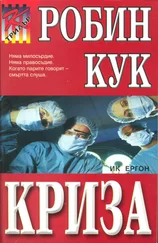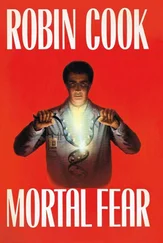Then in a normal voice, he asked the scrub nurse for some bayonet forceps and went back to work.
Martin calmly took his X rays down and left the OR. Changing back to his street clothes in the locker room, he tried not to think too much; it was easier on his mood. Heading back to Radiology, he allowed himself to ponder about the conflict in his sense of responsibility that the incident evoked. Dealing with Mannerheim called on resources he never imagined he’d need as a radiologist. He hadn’t resolved anything when he arrived back at the department.
“They are ready for you in the angiography room,” said Helen Walker when he reached his office. She stood up and followed him inside. Helen was an extremely gracious thirty-eight-year-old black woman from Queens who had been Philips’ secretary for five years. They had a wonderful working relationship. It terrorized Philips to think of her ever leaving, because like any good secretary she was instrumental in running Philips’ day-to-day life. Even Philips’ current wardrobe was the result of her efforts. He would have still been wearing the same boxy clothes he’d worn in college if Helen hadn’t teased him into meeting her in Bloomingdale’s one Saturday afternoon. The result had been a new Philips, and the contemporary fitted clothes suited his athletic body.
Philips tossed Mannerheim’s X rays onto his desk, where they merged with the other X rays, papers, journals and books. It was one place Philips forbade Helen to touch. No matter what his desk looked like he knew where everything was.
Helen stood behind him reading a steady stream of messages she felt obligated to tell him. Dr. Rees had called asking about the CAT scan on his patient, the X ray unit in the second angiography room had been fixed and was functioning normally, the emergency room called saying that they were expecting a severe head injury that was going to need an emergency CAT scan. It was endless and it was routine. Philips told her to handle everything, which was what she’d planned to do anyway, and she disappeared back to her desk.
Philips removed his white coat and put on the lead apron he wore during certain X-ray procedures to protect himself from the radiation. The bib of the apron was distinguished by a faded Superman monogram, which had resisted all attempts at removal. It had been drawn there in jest two years previously by the neuroradiology fellows. Knowing the gesture had been made out of respect, Martin had not been annoyed.
As he was about to leave, his eyes swept across the surface of his desk for a reassuring glimpse of the program cassette, just to make certain he hadn’t fantasized Michaels’ news. Not seeing it, Martin walked over to shuffle through the more recent layers of debris. He found the cassette under Mannerheim’s X rays. Philips started to leave, but again stopped. He picked up the cassette and Lisa Marino’s latest lateral skull X ray. Yelling through the open door for Helen to tell the angio room he’d be right there, he walked over to his worktable.
He took off his lead apron and draped it over a chair. He stared at the computed prototype, wondering if it would really work. The he held up Lisa Marino’s operative X ray to the light that came from the banks of viewing screens. He wasn’t interested in the electrode silhouettes and his mind eliminated them. What interested Philips was what the computer would say about the craniotomy. Philips knew they had not included the procedure in the program.
He flipped the switch on the central processor. A red light came on and he slowly inserted the cassette. He got it three-quarters of the way in, when the machine swallowed it like a hungry dog. Immediately the typewriter unit came alive. Philips moved over so he could read the output.
HI! I AM RADREAD, SKULL I. PLEASE ENTER PATIENT NAME.
Philips pecked out “Lisa Marino” with his two index fingers and entered it.
THANK YOU. PLEASE ENTER PRESENTING COMPLAINT.
Philips typed: “seizure disorder,” and entered that.
THANK YOU. PLEASE ENTER RELEVANT CLINICAL INFORMATION.
Philips typed: “21-year female, one year history of temporal lobe epilepsy.”
THANK YOU. PLEASE INSERT FILM IN LASER SCANNER.
Philips went over to the scanner. The rollers within the lips of the insertion slot were moving. Carefully Philips lined up the X ray with its emulsion side down. The machine grabbed it and pulled it inside. The output typewriter activated. Philips walked over. It said: THANK YOU. HAVE A CUP OF COFFEE. Philips smiled. Michaels’ sense of humor emerged when least expected.
The scanner emitted a slight electrical buzz; the output device stayed silent. Philips grabbed his lead apron and left the office.
There was silence in OR #21 as Mannerheim mobilized Lisa’s right temporal lobe and slowly lifted it from its base. A few small veins could be seen linking the specimen to the venous sinuses, and Newman skillfully coagulated and divided them. At last it was free, and Mannerheim lifted the piece of the brain out of Lisa’s skull and dropped it into a stainless steel dish held by Darlene Cooper, the scrub nurse. Mannerheim looked up at the clock. He was doing fine. As the operation had progressed, Mannerheim’s mood had changed again. Now he was euphoric and justly pleased with his performance. He’d done the procedure in half the usual time. He was certain he’d be in his office at noon.
“We’re not quite finished,” said Mannerheim, taking the metal sucker in his left hand and forceps in his right. Carefully he worked over the site where the temporal lobe had been, sucking out more brain tissue. He was removing what he called the deeper nuclei. This was probably the riskiest part of the procedure, but it was the part Mannerheim liked the best. With supreme confidence he guided the sucker, avoiding vital structures.
At one point a large globule of brain tissue momentarily blocked the opening of the sucker. There was a slight whistling noise, before the piece of tissue whooshed up the tube. “There go the music lessons,” said Mannerheim. It was a common neurosurgical quip, but coming from Mannerheim after all the tension he’d caused, it was funnier than usual. Everyone laughed, even the two Japanese doctors.
As soon as Mannerheim had finished removing brain tissue, Ranade slowed the ventilation of the patient. He wanted to let Lisa’s blood pressure rise a little while Mannerheim inspected the cavity for any bleeding. After a careful check Mannerheim was satisfied the operative site was dry. Taking a needle holder he began to close the dura, the tough covering over the brain. At that point, Ranade began carefully to lighten Lisa’s anesthesia. When the case was over he wanted to be able to remove the tube in Lisa’s trachea without her coughing, or straining. This required a delicate orchestration of all the drugs he’d been using. It was imperative that Lisa’s blood pressure not go up.
The dural closure went swiftly and with a deft rotation of his wrist, Mannerheim placed the last interrupted stitch. Lisa’s brain was again covered, although the dura dipped down and was darker where Lisa’s temporal lobe had been. Mannerheim cocked his head as he admired his handiwork, then stepping back, he snapped off his rubber gloves. The sound echoed in the room.
“All right,” said Mannerheim, “close her up. But let’s not make it your life’s work.”
Motioning for the two Japanese doctors to come with him, Mannerheim left the room.
Newman took Mannerheim’s position at Lisa’s head.
“Okay, Lowry,” said Newman, echoing his boss, “let’s see if you can help me rather than hinder me.”
After dropping the bone flap into place like the top of a Halloween pumpkin and tying the sutures, Newman was ready to close. With a pair of rugged tooth forceps, he grabbed hold of the edge of Lisa Marino’s wound and partially everted it. Then he plunged the needle deep into the skin of the scalp, making sure he picked up pericranium, and brought the needle out in the wound. Detaching the needle holder from its original position on the shank of the needle, he used the instrument to grab the needle tip, bringing the suture out into the wound. With essentially the same technique, he put the silk through the other side of the wound, trailing the suture off into Dr. Lowry’s waiting hand so he could tie the stitch. They repeated this procedure until the wound was closed with black sutures, giving the impression of a large zipper on the side of Lisa’s head.
Читать дальше












